Business Model Risk Project
VerifiedAdded on 2023/01/19
|13
|3367
|29
AI Summary
This project discusses the risk analysis and mitigation strategies for Volkswagen's business model. It explores how the emergence of electric vehicles poses a threat to the company's core activities and provides recommendations for reducing the impact of this risk.
Contribute Materials
Your contribution can guide someone’s learning journey. Share your
documents today.
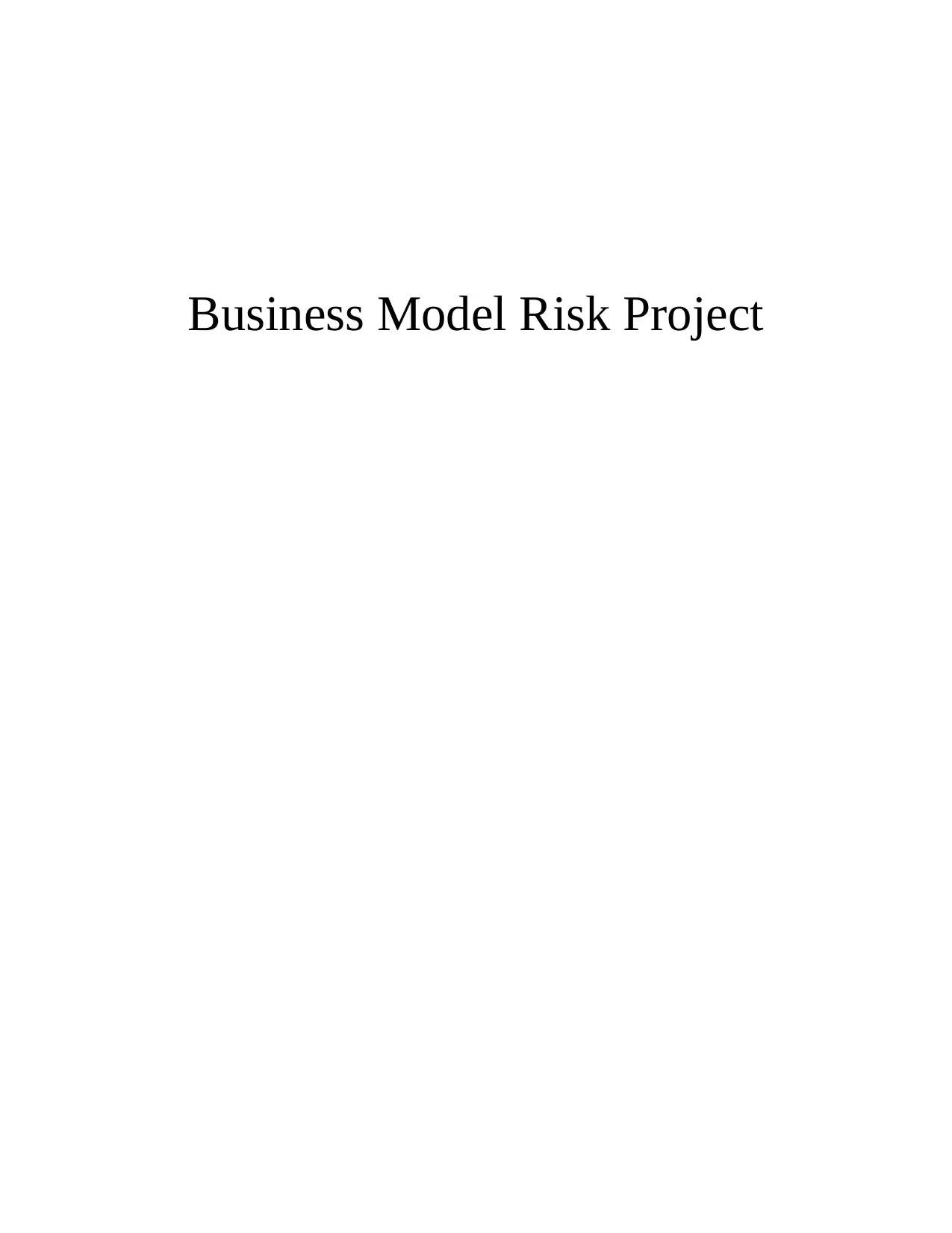
Business Model Risk Project
Secure Best Marks with AI Grader
Need help grading? Try our AI Grader for instant feedback on your assignments.
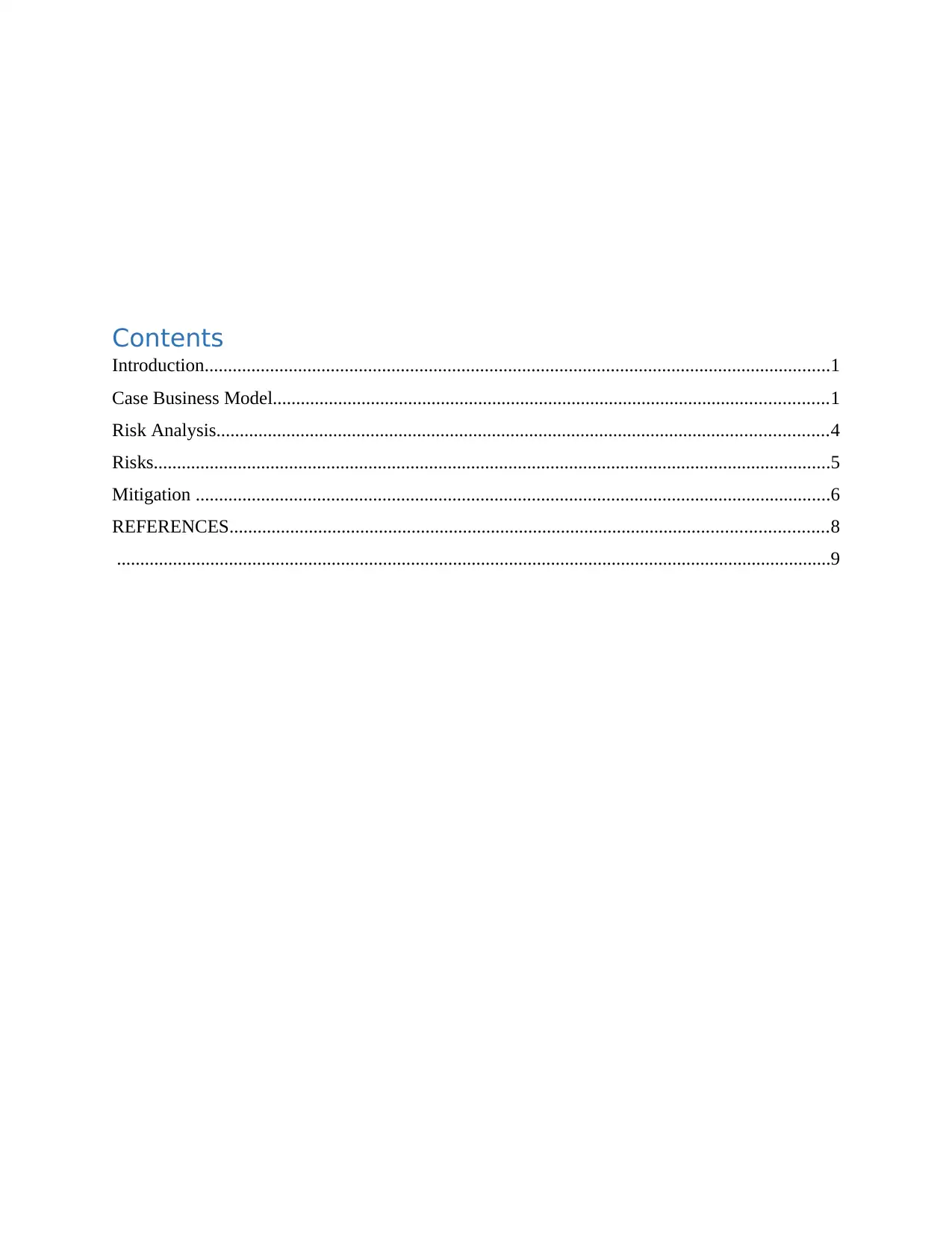
Contents
Introduction......................................................................................................................................1
Case Business Model.......................................................................................................................1
Risk Analysis...................................................................................................................................4
Risks.................................................................................................................................................5
Mitigation ........................................................................................................................................6
REFERENCES................................................................................................................................8
.........................................................................................................................................................9
Introduction......................................................................................................................................1
Case Business Model.......................................................................................................................1
Risk Analysis...................................................................................................................................4
Risks.................................................................................................................................................5
Mitigation ........................................................................................................................................6
REFERENCES................................................................................................................................8
.........................................................................................................................................................9

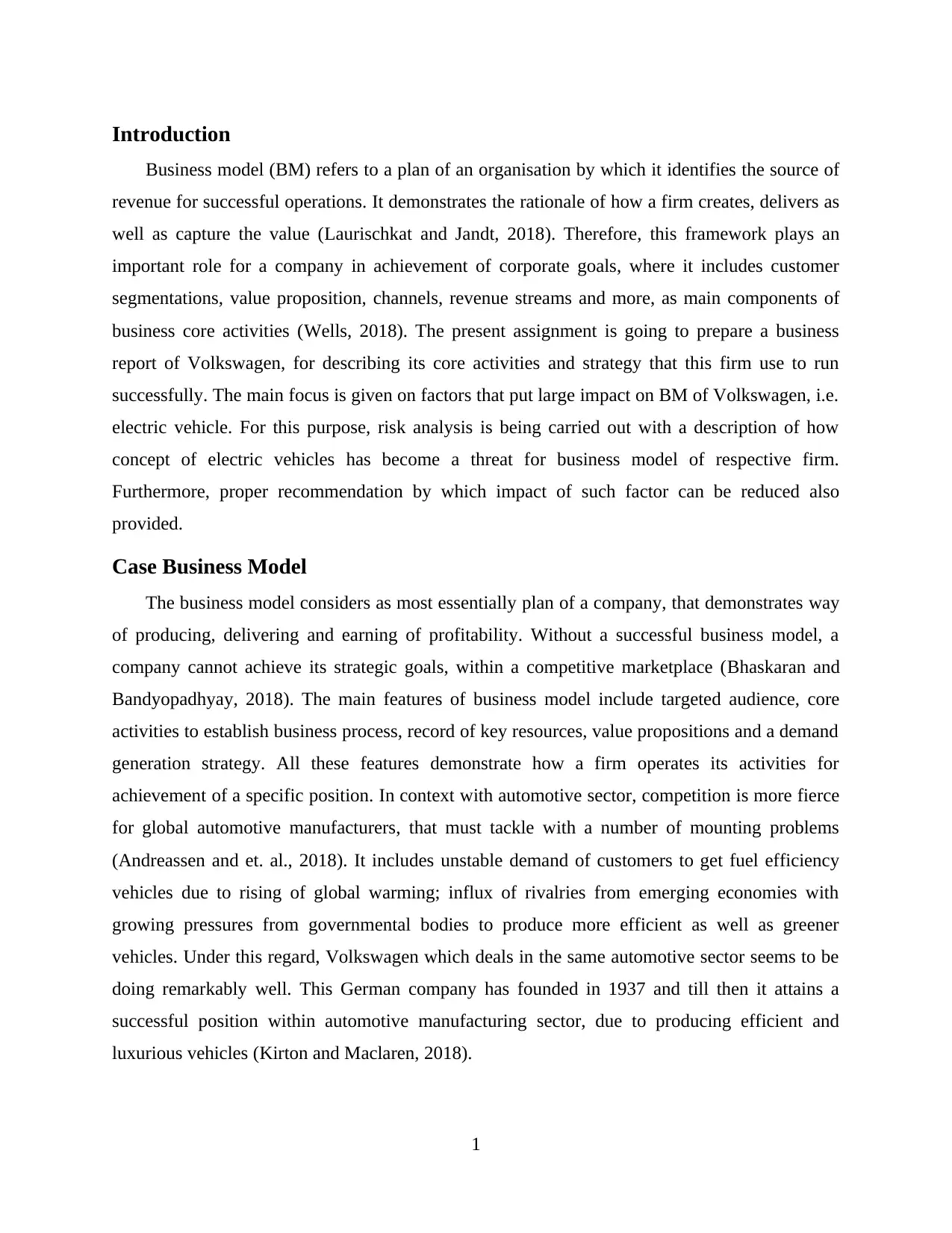
Introduction
Business model (BM) refers to a plan of an organisation by which it identifies the source of
revenue for successful operations. It demonstrates the rationale of how a firm creates, delivers as
well as capture the value (Laurischkat and Jandt, 2018). Therefore, this framework plays an
important role for a company in achievement of corporate goals, where it includes customer
segmentations, value proposition, channels, revenue streams and more, as main components of
business core activities (Wells, 2018). The present assignment is going to prepare a business
report of Volkswagen, for describing its core activities and strategy that this firm use to run
successfully. The main focus is given on factors that put large impact on BM of Volkswagen, i.e.
electric vehicle. For this purpose, risk analysis is being carried out with a description of how
concept of electric vehicles has become a threat for business model of respective firm.
Furthermore, proper recommendation by which impact of such factor can be reduced also
provided.
Case Business Model
The business model considers as most essentially plan of a company, that demonstrates way
of producing, delivering and earning of profitability. Without a successful business model, a
company cannot achieve its strategic goals, within a competitive marketplace (Bhaskaran and
Bandyopadhyay, 2018). The main features of business model include targeted audience, core
activities to establish business process, record of key resources, value propositions and a demand
generation strategy. All these features demonstrate how a firm operates its activities for
achievement of a specific position. In context with automotive sector, competition is more fierce
for global automotive manufacturers, that must tackle with a number of mounting problems
(Andreassen and et. al., 2018). It includes unstable demand of customers to get fuel efficiency
vehicles due to rising of global warming; influx of rivalries from emerging economies with
growing pressures from governmental bodies to produce more efficient as well as greener
vehicles. Under this regard, Volkswagen which deals in the same automotive sector seems to be
doing remarkably well. This German company has founded in 1937 and till then it attains a
successful position within automotive manufacturing sector, due to producing efficient and
luxurious vehicles (Kirton and Maclaren, 2018).
1
Business model (BM) refers to a plan of an organisation by which it identifies the source of
revenue for successful operations. It demonstrates the rationale of how a firm creates, delivers as
well as capture the value (Laurischkat and Jandt, 2018). Therefore, this framework plays an
important role for a company in achievement of corporate goals, where it includes customer
segmentations, value proposition, channels, revenue streams and more, as main components of
business core activities (Wells, 2018). The present assignment is going to prepare a business
report of Volkswagen, for describing its core activities and strategy that this firm use to run
successfully. The main focus is given on factors that put large impact on BM of Volkswagen, i.e.
electric vehicle. For this purpose, risk analysis is being carried out with a description of how
concept of electric vehicles has become a threat for business model of respective firm.
Furthermore, proper recommendation by which impact of such factor can be reduced also
provided.
Case Business Model
The business model considers as most essentially plan of a company, that demonstrates way
of producing, delivering and earning of profitability. Without a successful business model, a
company cannot achieve its strategic goals, within a competitive marketplace (Bhaskaran and
Bandyopadhyay, 2018). The main features of business model include targeted audience, core
activities to establish business process, record of key resources, value propositions and a demand
generation strategy. All these features demonstrate how a firm operates its activities for
achievement of a specific position. In context with automotive sector, competition is more fierce
for global automotive manufacturers, that must tackle with a number of mounting problems
(Andreassen and et. al., 2018). It includes unstable demand of customers to get fuel efficiency
vehicles due to rising of global warming; influx of rivalries from emerging economies with
growing pressures from governmental bodies to produce more efficient as well as greener
vehicles. Under this regard, Volkswagen which deals in the same automotive sector seems to be
doing remarkably well. This German company has founded in 1937 and till then it attains a
successful position within automotive manufacturing sector, due to producing efficient and
luxurious vehicles (Kirton and Maclaren, 2018).
1
Secure Best Marks with AI Grader
Need help grading? Try our AI Grader for instant feedback on your assignments.
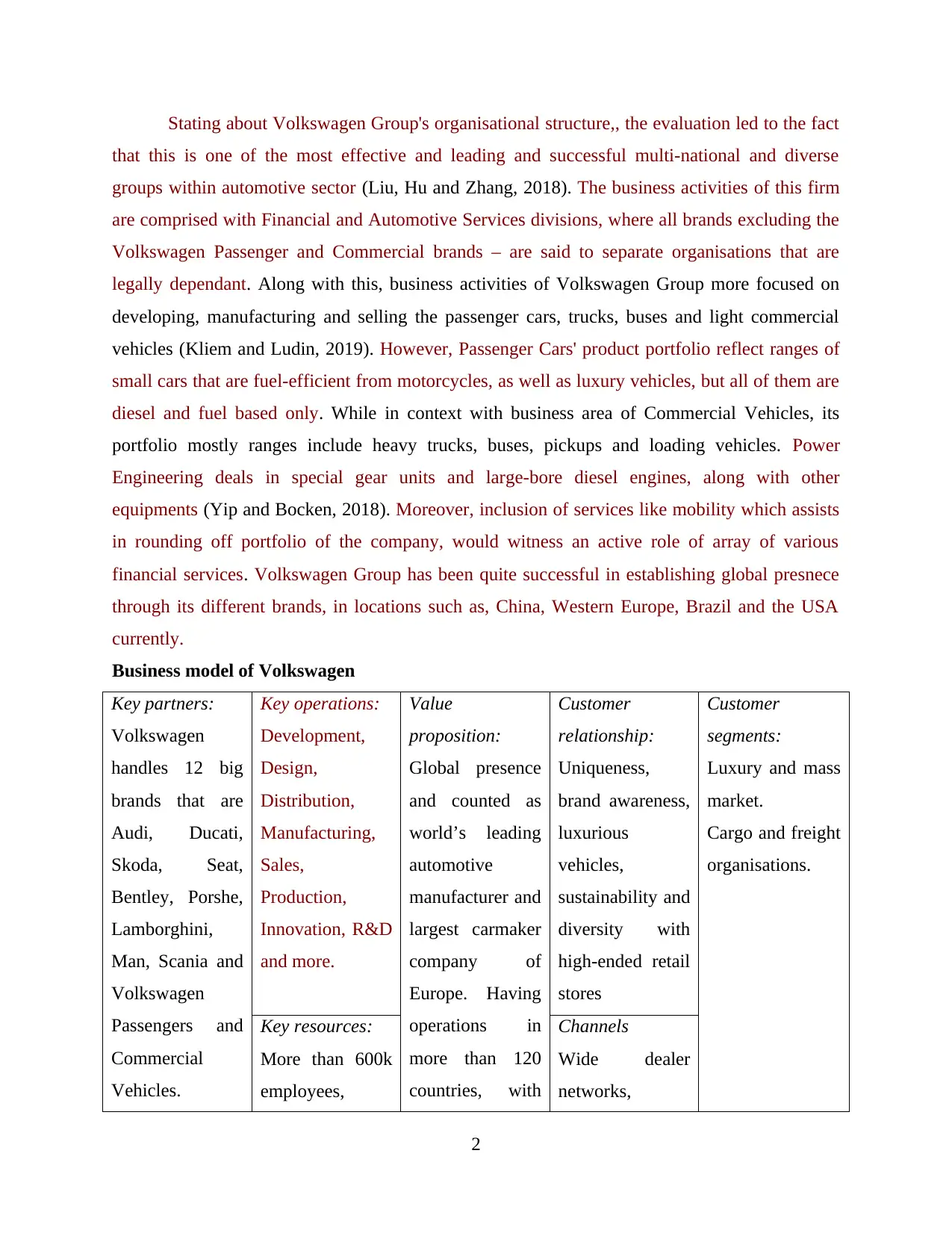
Stating about Volkswagen Group's organisational structure,, the evaluation led to the fact
that this is one of the most effective and leading and successful multi-national and diverse
groups within automotive sector (Liu, Hu and Zhang, 2018). The business activities of this firm
are comprised with Financial and Automotive Services divisions, where all brands excluding the
Volkswagen Passenger and Commercial brands – are said to separate organisations that are
legally dependant. Along with this, business activities of Volkswagen Group more focused on
developing, manufacturing and selling the passenger cars, trucks, buses and light commercial
vehicles (Kliem and Ludin, 2019). However, Passenger Cars' product portfolio reflect ranges of
small cars that are fuel-efficient from motorcycles, as well as luxury vehicles, but all of them are
diesel and fuel based only. While in context with business area of Commercial Vehicles, its
portfolio mostly ranges include heavy trucks, buses, pickups and loading vehicles. Power
Engineering deals in special gear units and large-bore diesel engines, along with other
equipments (Yip and Bocken, 2018). Moreover, inclusion of services like mobility which assists
in rounding off portfolio of the company, would witness an active role of array of various
financial services. Volkswagen Group has been quite successful in establishing global presnece
through its different brands, in locations such as, China, Western Europe, Brazil and the USA
currently.
Business model of Volkswagen
Key partners:
Volkswagen
handles 12 big
brands that are
Audi, Ducati,
Skoda, Seat,
Bentley, Porshe,
Lamborghini,
Man, Scania and
Volkswagen
Passengers and
Commercial
Vehicles.
Key operations:
Development,
Design,
Distribution,
Manufacturing,
Sales,
Production,
Innovation, R&D
and more.
Value
proposition:
Global presence
and counted as
world’s leading
automotive
manufacturer and
largest carmaker
company of
Europe. Having
operations in
more than 120
countries, with
Customer
relationship:
Uniqueness,
brand awareness,
luxurious
vehicles,
sustainability and
diversity with
high-ended retail
stores
Customer
segments:
Luxury and mass
market.
Cargo and freight
organisations.
Key resources:
More than 600k
employees,
Channels
Wide dealer
networks,
2
that this is one of the most effective and leading and successful multi-national and diverse
groups within automotive sector (Liu, Hu and Zhang, 2018). The business activities of this firm
are comprised with Financial and Automotive Services divisions, where all brands excluding the
Volkswagen Passenger and Commercial brands – are said to separate organisations that are
legally dependant. Along with this, business activities of Volkswagen Group more focused on
developing, manufacturing and selling the passenger cars, trucks, buses and light commercial
vehicles (Kliem and Ludin, 2019). However, Passenger Cars' product portfolio reflect ranges of
small cars that are fuel-efficient from motorcycles, as well as luxury vehicles, but all of them are
diesel and fuel based only. While in context with business area of Commercial Vehicles, its
portfolio mostly ranges include heavy trucks, buses, pickups and loading vehicles. Power
Engineering deals in special gear units and large-bore diesel engines, along with other
equipments (Yip and Bocken, 2018). Moreover, inclusion of services like mobility which assists
in rounding off portfolio of the company, would witness an active role of array of various
financial services. Volkswagen Group has been quite successful in establishing global presnece
through its different brands, in locations such as, China, Western Europe, Brazil and the USA
currently.
Business model of Volkswagen
Key partners:
Volkswagen
handles 12 big
brands that are
Audi, Ducati,
Skoda, Seat,
Bentley, Porshe,
Lamborghini,
Man, Scania and
Volkswagen
Passengers and
Commercial
Vehicles.
Key operations:
Development,
Design,
Distribution,
Manufacturing,
Sales,
Production,
Innovation, R&D
and more.
Value
proposition:
Global presence
and counted as
world’s leading
automotive
manufacturer and
largest carmaker
company of
Europe. Having
operations in
more than 120
countries, with
Customer
relationship:
Uniqueness,
brand awareness,
luxurious
vehicles,
sustainability and
diversity with
high-ended retail
stores
Customer
segments:
Luxury and mass
market.
Cargo and freight
organisations.
Key resources:
More than 600k
employees,
Channels
Wide dealer
networks,
2
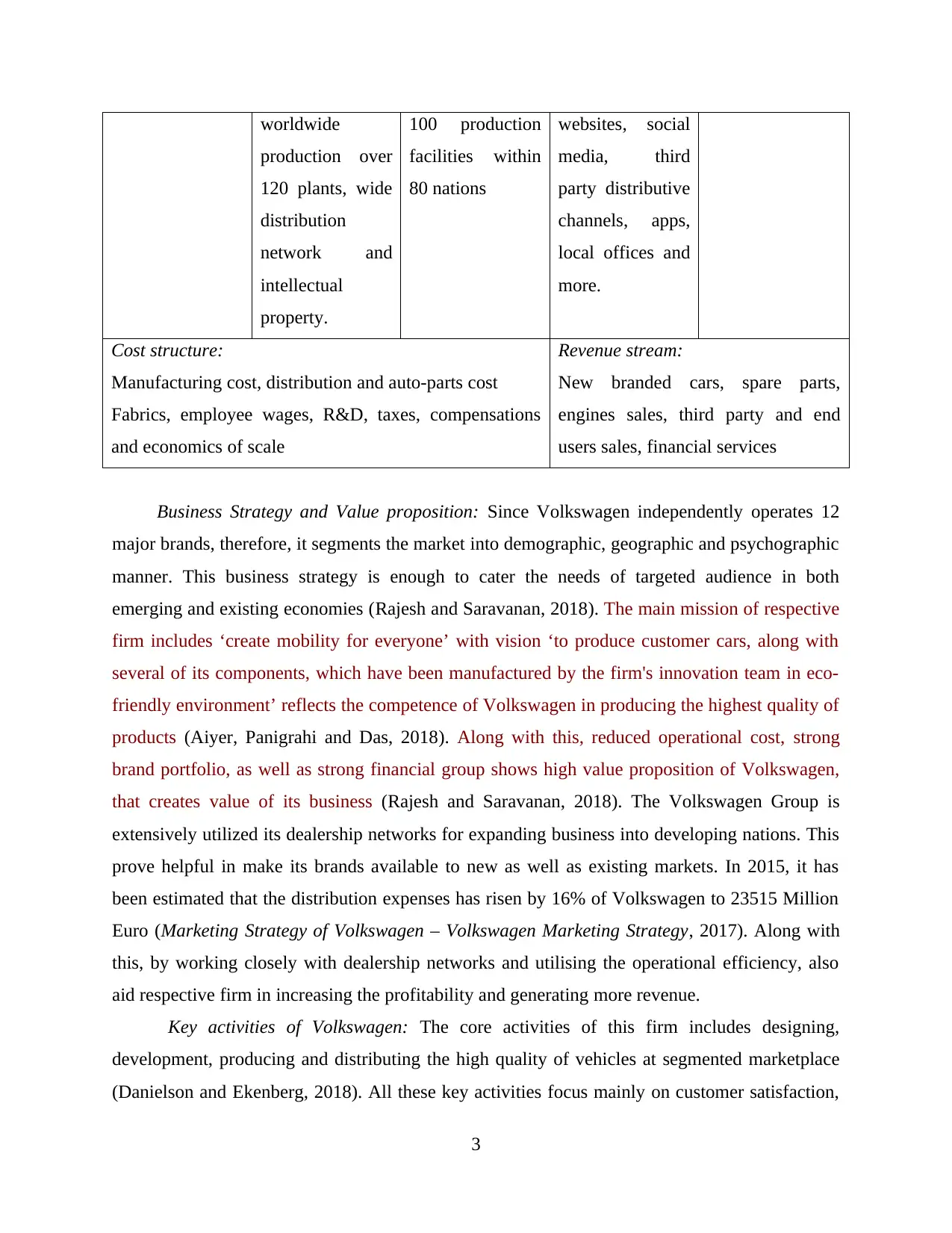
worldwide
production over
120 plants, wide
distribution
network and
intellectual
property.
100 production
facilities within
80 nations
websites, social
media, third
party distributive
channels, apps,
local offices and
more.
Cost structure:
Manufacturing cost, distribution and auto-parts cost
Fabrics, employee wages, R&D, taxes, compensations
and economics of scale
Revenue stream:
New branded cars, spare parts,
engines sales, third party and end
users sales, financial services
Business Strategy and Value proposition: Since Volkswagen independently operates 12
major brands, therefore, it segments the market into demographic, geographic and psychographic
manner. This business strategy is enough to cater the needs of targeted audience in both
emerging and existing economies (Rajesh and Saravanan, 2018). The main mission of respective
firm includes ‘create mobility for everyone’ with vision ‘to produce customer cars, along with
several of its components, which have been manufactured by the firm's innovation team in eco-
friendly environment’ reflects the competence of Volkswagen in producing the highest quality of
products (Aiyer, Panigrahi and Das, 2018). Along with this, reduced operational cost, strong
brand portfolio, as well as strong financial group shows high value proposition of Volkswagen,
that creates value of its business (Rajesh and Saravanan, 2018). The Volkswagen Group is
extensively utilized its dealership networks for expanding business into developing nations. This
prove helpful in make its brands available to new as well as existing markets. In 2015, it has
been estimated that the distribution expenses has risen by 16% of Volkswagen to 23515 Million
Euro (Marketing Strategy of Volkswagen – Volkswagen Marketing Strategy, 2017). Along with
this, by working closely with dealership networks and utilising the operational efficiency, also
aid respective firm in increasing the profitability and generating more revenue.
Key activities of Volkswagen: The core activities of this firm includes designing,
development, producing and distributing the high quality of vehicles at segmented marketplace
(Danielson and Ekenberg, 2018). All these key activities focus mainly on customer satisfaction,
3
production over
120 plants, wide
distribution
network and
intellectual
property.
100 production
facilities within
80 nations
websites, social
media, third
party distributive
channels, apps,
local offices and
more.
Cost structure:
Manufacturing cost, distribution and auto-parts cost
Fabrics, employee wages, R&D, taxes, compensations
and economics of scale
Revenue stream:
New branded cars, spare parts,
engines sales, third party and end
users sales, financial services
Business Strategy and Value proposition: Since Volkswagen independently operates 12
major brands, therefore, it segments the market into demographic, geographic and psychographic
manner. This business strategy is enough to cater the needs of targeted audience in both
emerging and existing economies (Rajesh and Saravanan, 2018). The main mission of respective
firm includes ‘create mobility for everyone’ with vision ‘to produce customer cars, along with
several of its components, which have been manufactured by the firm's innovation team in eco-
friendly environment’ reflects the competence of Volkswagen in producing the highest quality of
products (Aiyer, Panigrahi and Das, 2018). Along with this, reduced operational cost, strong
brand portfolio, as well as strong financial group shows high value proposition of Volkswagen,
that creates value of its business (Rajesh and Saravanan, 2018). The Volkswagen Group is
extensively utilized its dealership networks for expanding business into developing nations. This
prove helpful in make its brands available to new as well as existing markets. In 2015, it has
been estimated that the distribution expenses has risen by 16% of Volkswagen to 23515 Million
Euro (Marketing Strategy of Volkswagen – Volkswagen Marketing Strategy, 2017). Along with
this, by working closely with dealership networks and utilising the operational efficiency, also
aid respective firm in increasing the profitability and generating more revenue.
Key activities of Volkswagen: The core activities of this firm includes designing,
development, producing and distributing the high quality of vehicles at segmented marketplace
(Danielson and Ekenberg, 2018). All these key activities focus mainly on customer satisfaction,
3
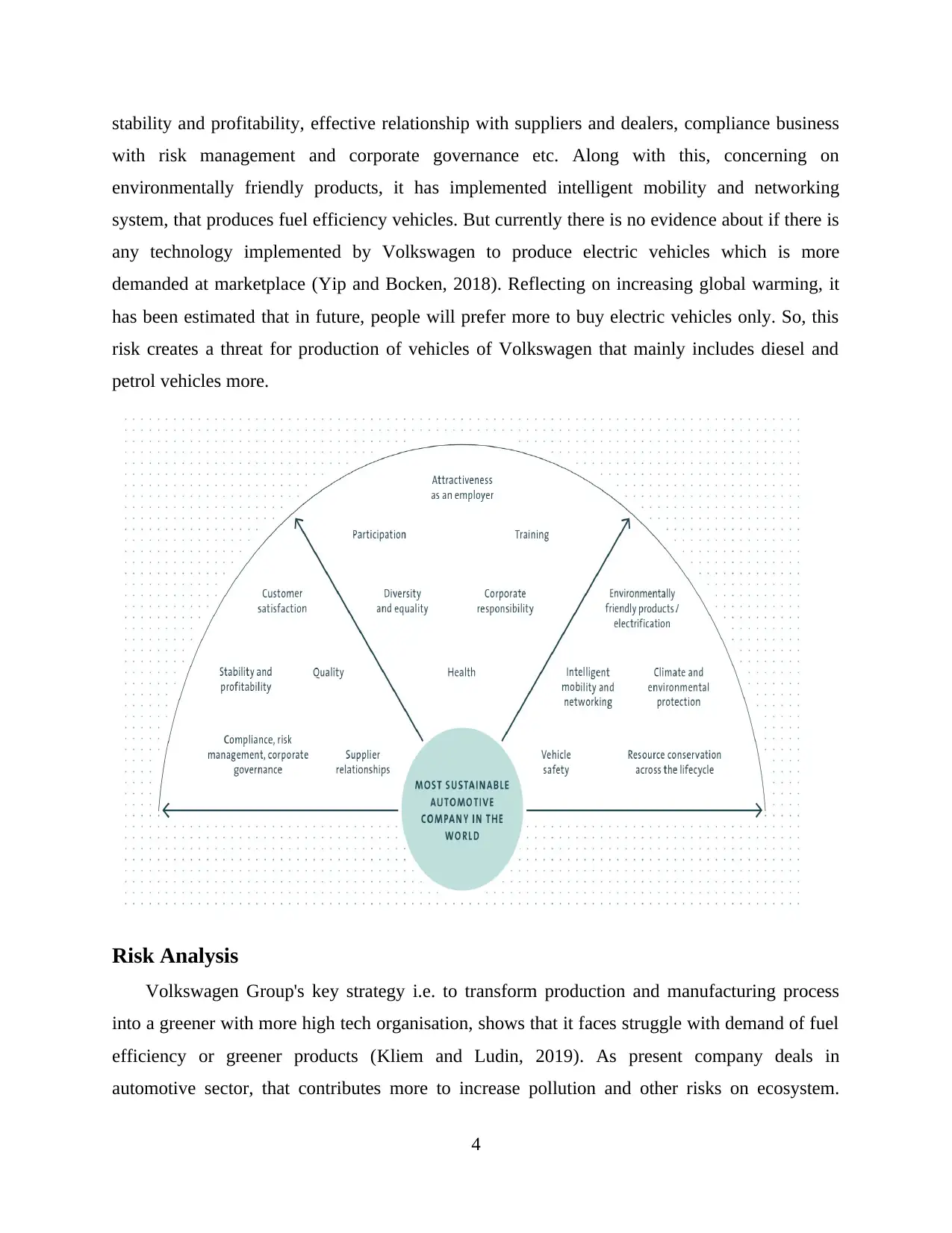
stability and profitability, effective relationship with suppliers and dealers, compliance business
with risk management and corporate governance etc. Along with this, concerning on
environmentally friendly products, it has implemented intelligent mobility and networking
system, that produces fuel efficiency vehicles. But currently there is no evidence about if there is
any technology implemented by Volkswagen to produce electric vehicles which is more
demanded at marketplace (Yip and Bocken, 2018). Reflecting on increasing global warming, it
has been estimated that in future, people will prefer more to buy electric vehicles only. So, this
risk creates a threat for production of vehicles of Volkswagen that mainly includes diesel and
petrol vehicles more.
Risk Analysis
Volkswagen Group's key strategy i.e. to transform production and manufacturing process
into a greener with more high tech organisation, shows that it faces struggle with demand of fuel
efficiency or greener products (Kliem and Ludin, 2019). As present company deals in
automotive sector, that contributes more to increase pollution and other risks on ecosystem.
4
with risk management and corporate governance etc. Along with this, concerning on
environmentally friendly products, it has implemented intelligent mobility and networking
system, that produces fuel efficiency vehicles. But currently there is no evidence about if there is
any technology implemented by Volkswagen to produce electric vehicles which is more
demanded at marketplace (Yip and Bocken, 2018). Reflecting on increasing global warming, it
has been estimated that in future, people will prefer more to buy electric vehicles only. So, this
risk creates a threat for production of vehicles of Volkswagen that mainly includes diesel and
petrol vehicles more.
Risk Analysis
Volkswagen Group's key strategy i.e. to transform production and manufacturing process
into a greener with more high tech organisation, shows that it faces struggle with demand of fuel
efficiency or greener products (Kliem and Ludin, 2019). As present company deals in
automotive sector, that contributes more to increase pollution and other risks on ecosystem.
4
Paraphrase This Document
Need a fresh take? Get an instant paraphrase of this document with our AI Paraphraser
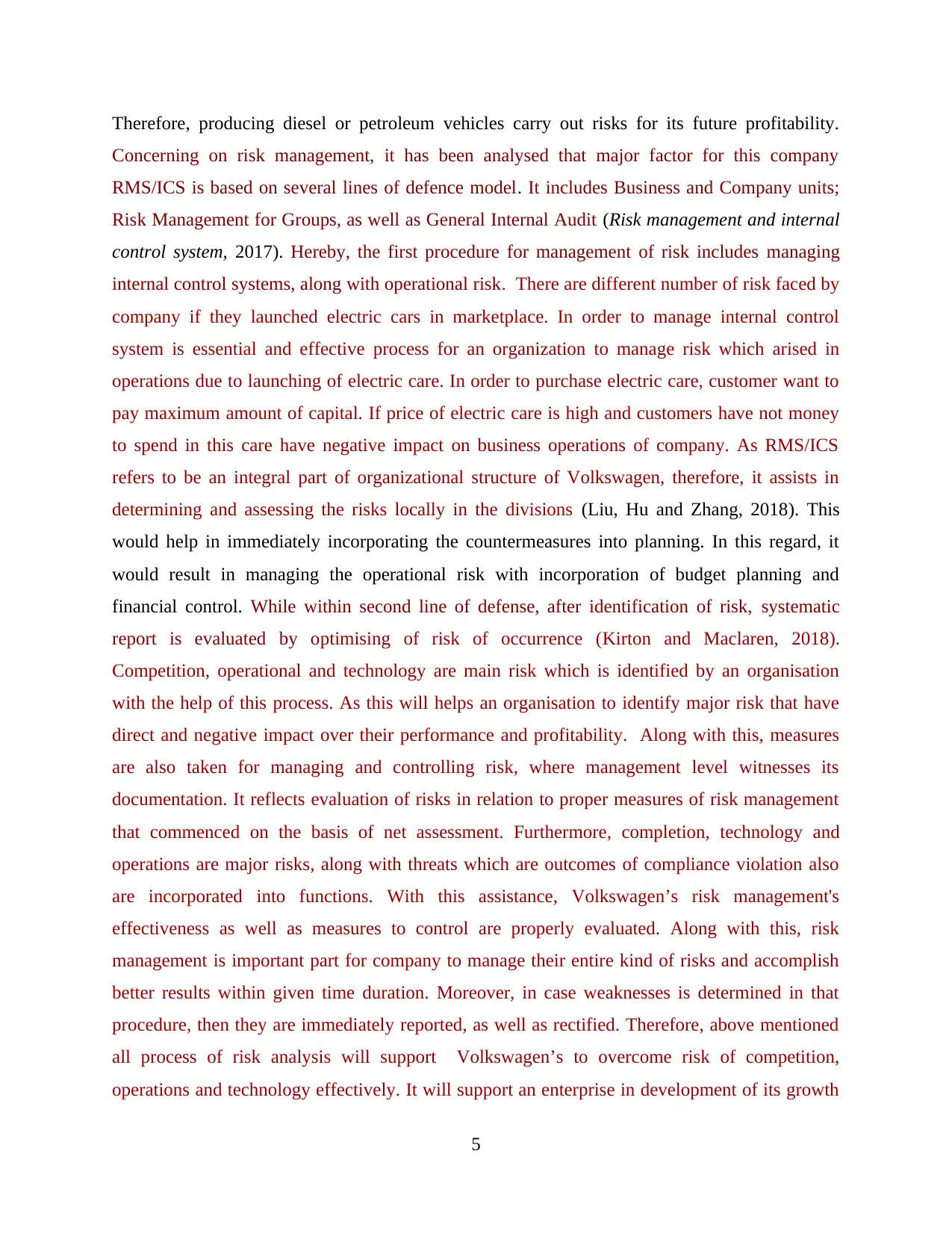
Therefore, producing diesel or petroleum vehicles carry out risks for its future profitability.
Concerning on risk management, it has been analysed that major factor for this company
RMS/ICS is based on several lines of defence model. It includes Business and Company units;
Risk Management for Groups, as well as General Internal Audit (Risk management and internal
control system, 2017). Hereby, the first procedure for management of risk includes managing
internal control systems, along with operational risk. There are different number of risk faced by
company if they launched electric cars in marketplace. In order to manage internal control
system is essential and effective process for an organization to manage risk which arised in
operations due to launching of electric care. In order to purchase electric care, customer want to
pay maximum amount of capital. If price of electric care is high and customers have not money
to spend in this care have negative impact on business operations of company. As RMS/ICS
refers to be an integral part of organizational structure of Volkswagen, therefore, it assists in
determining and assessing the risks locally in the divisions (Liu, Hu and Zhang, 2018). This
would help in immediately incorporating the countermeasures into planning. In this regard, it
would result in managing the operational risk with incorporation of budget planning and
financial control. While within second line of defense, after identification of risk, systematic
report is evaluated by optimising of risk of occurrence (Kirton and Maclaren, 2018).
Competition, operational and technology are main risk which is identified by an organisation
with the help of this process. As this will helps an organisation to identify major risk that have
direct and negative impact over their performance and profitability. Along with this, measures
are also taken for managing and controlling risk, where management level witnesses its
documentation. It reflects evaluation of risks in relation to proper measures of risk management
that commenced on the basis of net assessment. Furthermore, completion, technology and
operations are major risks, along with threats which are outcomes of compliance violation also
are incorporated into functions. With this assistance, Volkswagen’s risk management's
effectiveness as well as measures to control are properly evaluated. Along with this, risk
management is important part for company to manage their entire kind of risks and accomplish
better results within given time duration. Moreover, in case weaknesses is determined in that
procedure, then they are immediately reported, as well as rectified. Therefore, above mentioned
all process of risk analysis will support Volkswagen’s to overcome risk of competition,
operations and technology effectively. It will support an enterprise in development of its growth
5
Concerning on risk management, it has been analysed that major factor for this company
RMS/ICS is based on several lines of defence model. It includes Business and Company units;
Risk Management for Groups, as well as General Internal Audit (Risk management and internal
control system, 2017). Hereby, the first procedure for management of risk includes managing
internal control systems, along with operational risk. There are different number of risk faced by
company if they launched electric cars in marketplace. In order to manage internal control
system is essential and effective process for an organization to manage risk which arised in
operations due to launching of electric care. In order to purchase electric care, customer want to
pay maximum amount of capital. If price of electric care is high and customers have not money
to spend in this care have negative impact on business operations of company. As RMS/ICS
refers to be an integral part of organizational structure of Volkswagen, therefore, it assists in
determining and assessing the risks locally in the divisions (Liu, Hu and Zhang, 2018). This
would help in immediately incorporating the countermeasures into planning. In this regard, it
would result in managing the operational risk with incorporation of budget planning and
financial control. While within second line of defense, after identification of risk, systematic
report is evaluated by optimising of risk of occurrence (Kirton and Maclaren, 2018).
Competition, operational and technology are main risk which is identified by an organisation
with the help of this process. As this will helps an organisation to identify major risk that have
direct and negative impact over their performance and profitability. Along with this, measures
are also taken for managing and controlling risk, where management level witnesses its
documentation. It reflects evaluation of risks in relation to proper measures of risk management
that commenced on the basis of net assessment. Furthermore, completion, technology and
operations are major risks, along with threats which are outcomes of compliance violation also
are incorporated into functions. With this assistance, Volkswagen’s risk management's
effectiveness as well as measures to control are properly evaluated. Along with this, risk
management is important part for company to manage their entire kind of risks and accomplish
better results within given time duration. Moreover, in case weaknesses is determined in that
procedure, then they are immediately reported, as well as rectified. Therefore, above mentioned
all process of risk analysis will support Volkswagen’s to overcome risk of competition,
operations and technology effectively. It will support an enterprise in development of its growth
5
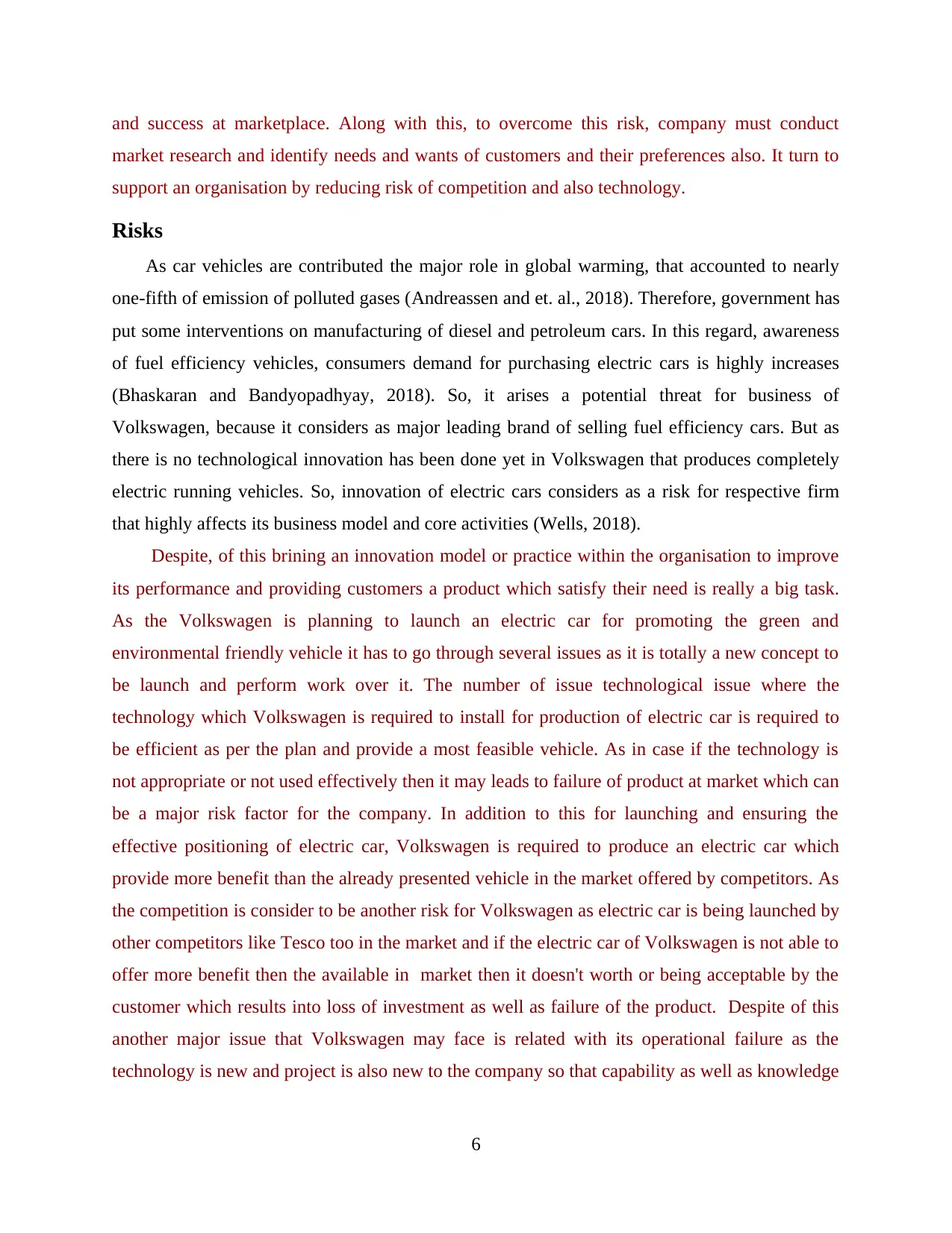
and success at marketplace. Along with this, to overcome this risk, company must conduct
market research and identify needs and wants of customers and their preferences also. It turn to
support an organisation by reducing risk of competition and also technology.
Risks
As car vehicles are contributed the major role in global warming, that accounted to nearly
one-fifth of emission of polluted gases (Andreassen and et. al., 2018). Therefore, government has
put some interventions on manufacturing of diesel and petroleum cars. In this regard, awareness
of fuel efficiency vehicles, consumers demand for purchasing electric cars is highly increases
(Bhaskaran and Bandyopadhyay, 2018). So, it arises a potential threat for business of
Volkswagen, because it considers as major leading brand of selling fuel efficiency cars. But as
there is no technological innovation has been done yet in Volkswagen that produces completely
electric running vehicles. So, innovation of electric cars considers as a risk for respective firm
that highly affects its business model and core activities (Wells, 2018).
Despite, of this brining an innovation model or practice within the organisation to improve
its performance and providing customers a product which satisfy their need is really a big task.
As the Volkswagen is planning to launch an electric car for promoting the green and
environmental friendly vehicle it has to go through several issues as it is totally a new concept to
be launch and perform work over it. The number of issue technological issue where the
technology which Volkswagen is required to install for production of electric car is required to
be efficient as per the plan and provide a most feasible vehicle. As in case if the technology is
not appropriate or not used effectively then it may leads to failure of product at market which can
be a major risk factor for the company. In addition to this for launching and ensuring the
effective positioning of electric car, Volkswagen is required to produce an electric car which
provide more benefit than the already presented vehicle in the market offered by competitors. As
the competition is consider to be another risk for Volkswagen as electric car is being launched by
other competitors like Tesco too in the market and if the electric car of Volkswagen is not able to
offer more benefit then the available in market then it doesn't worth or being acceptable by the
customer which results into loss of investment as well as failure of the product. Despite of this
another major issue that Volkswagen may face is related with its operational failure as the
technology is new and project is also new to the company so that capability as well as knowledge
6
market research and identify needs and wants of customers and their preferences also. It turn to
support an organisation by reducing risk of competition and also technology.
Risks
As car vehicles are contributed the major role in global warming, that accounted to nearly
one-fifth of emission of polluted gases (Andreassen and et. al., 2018). Therefore, government has
put some interventions on manufacturing of diesel and petroleum cars. In this regard, awareness
of fuel efficiency vehicles, consumers demand for purchasing electric cars is highly increases
(Bhaskaran and Bandyopadhyay, 2018). So, it arises a potential threat for business of
Volkswagen, because it considers as major leading brand of selling fuel efficiency cars. But as
there is no technological innovation has been done yet in Volkswagen that produces completely
electric running vehicles. So, innovation of electric cars considers as a risk for respective firm
that highly affects its business model and core activities (Wells, 2018).
Despite, of this brining an innovation model or practice within the organisation to improve
its performance and providing customers a product which satisfy their need is really a big task.
As the Volkswagen is planning to launch an electric car for promoting the green and
environmental friendly vehicle it has to go through several issues as it is totally a new concept to
be launch and perform work over it. The number of issue technological issue where the
technology which Volkswagen is required to install for production of electric car is required to
be efficient as per the plan and provide a most feasible vehicle. As in case if the technology is
not appropriate or not used effectively then it may leads to failure of product at market which can
be a major risk factor for the company. In addition to this for launching and ensuring the
effective positioning of electric car, Volkswagen is required to produce an electric car which
provide more benefit than the already presented vehicle in the market offered by competitors. As
the competition is consider to be another risk for Volkswagen as electric car is being launched by
other competitors like Tesco too in the market and if the electric car of Volkswagen is not able to
offer more benefit then the available in market then it doesn't worth or being acceptable by the
customer which results into loss of investment as well as failure of the product. Despite of this
another major issue that Volkswagen may face is related with its operational failure as the
technology is new and project is also new to the company so that capability as well as knowledge
6

of existing team, may not be as per the model which in turn may affect its performance or its
final outcoem that may leads to failure of project.
For mitigating this risk, it has to create a major change in entire operational and business
plan, that requires more costs. Therefore, innovation of electric vehicles has completely
disrupted the automotive sector, that assists organisations to make huge investment in electric
vehicle division. Along with this, significant changes within internal activities require to put
more efforts in R&D department, with demand of new supply chain partnership. Volkswagen
also need to move its new technology with transformation of business model and emergence of
electric vehicles (Laurischkat and Jandt, 2018). It has also been evaluated that in future,
Government will take this initiate of electric vehicles more seriously, in order to reduce the
carbon footprint from environment. In addition to this, if Volkswagen switch to electric power
train then it may highly affect the suppliers also, because only few suppliers are in state of taking
the appropriate initiatives to survive in such market. So, all these factors reflect that mitigating
the emergence of electric vehicles contributes a major threat or risk for profitability of
Volkswagen in future.
Mitigation
The automotive industry seems to be entered into a new era, that driven by increasing move
toward hybrid-powered and electric vehicles, with development of autonomous technology. So,
it shifts their business model i.e. mechanically driven technology into electric. Thus, in this
regard, electric vehicles are considered as new trend within automotive industry that completely
disrupts the current business activities of various companies including Volkswagen. Therefore,
to mitigate this risk into business model, it is recommended to respective firm align risk with
corporate strategic goals. Through following techniques, Volkswagen can easily mitigate the risk
of electric vehicles –
Align the risk management process i.e. ICS/RCM with corporate strategy, which would
help in developing the planning of scenario for more effective understanding of the
implication of risks on current and future objectives of business.
Through emergence of latest risks, Volkswagen can determine trends which will need
more appropriate attention. Business interruption as an instance, can move risks from
tangible to virtual manner.
7
final outcoem that may leads to failure of project.
For mitigating this risk, it has to create a major change in entire operational and business
plan, that requires more costs. Therefore, innovation of electric vehicles has completely
disrupted the automotive sector, that assists organisations to make huge investment in electric
vehicle division. Along with this, significant changes within internal activities require to put
more efforts in R&D department, with demand of new supply chain partnership. Volkswagen
also need to move its new technology with transformation of business model and emergence of
electric vehicles (Laurischkat and Jandt, 2018). It has also been evaluated that in future,
Government will take this initiate of electric vehicles more seriously, in order to reduce the
carbon footprint from environment. In addition to this, if Volkswagen switch to electric power
train then it may highly affect the suppliers also, because only few suppliers are in state of taking
the appropriate initiatives to survive in such market. So, all these factors reflect that mitigating
the emergence of electric vehicles contributes a major threat or risk for profitability of
Volkswagen in future.
Mitigation
The automotive industry seems to be entered into a new era, that driven by increasing move
toward hybrid-powered and electric vehicles, with development of autonomous technology. So,
it shifts their business model i.e. mechanically driven technology into electric. Thus, in this
regard, electric vehicles are considered as new trend within automotive industry that completely
disrupts the current business activities of various companies including Volkswagen. Therefore,
to mitigate this risk into business model, it is recommended to respective firm align risk with
corporate strategic goals. Through following techniques, Volkswagen can easily mitigate the risk
of electric vehicles –
Align the risk management process i.e. ICS/RCM with corporate strategy, which would
help in developing the planning of scenario for more effective understanding of the
implication of risks on current and future objectives of business.
Through emergence of latest risks, Volkswagen can determine trends which will need
more appropriate attention. Business interruption as an instance, can move risks from
tangible to virtual manner.
7
Secure Best Marks with AI Grader
Need help grading? Try our AI Grader for instant feedback on your assignments.
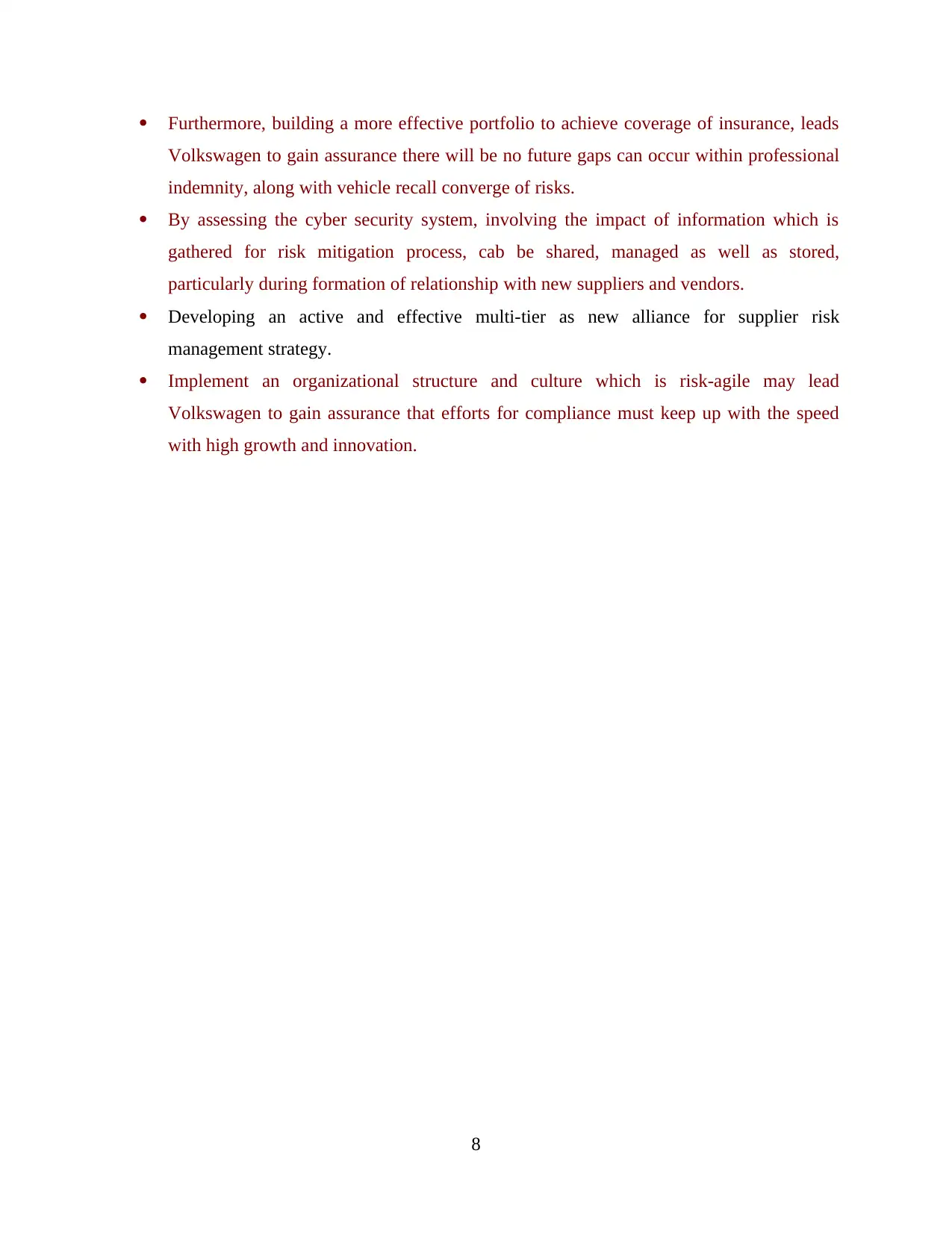
Furthermore, building a more effective portfolio to achieve coverage of insurance, leads
Volkswagen to gain assurance there will be no future gaps can occur within professional
indemnity, along with vehicle recall converge of risks.
By assessing the cyber security system, involving the impact of information which is
gathered for risk mitigation process, cab be shared, managed as well as stored,
particularly during formation of relationship with new suppliers and vendors.
Developing an active and effective multi-tier as new alliance for supplier risk
management strategy.
Implement an organizational structure and culture which is risk-agile may lead
Volkswagen to gain assurance that efforts for compliance must keep up with the speed
with high growth and innovation.
8
Volkswagen to gain assurance there will be no future gaps can occur within professional
indemnity, along with vehicle recall converge of risks.
By assessing the cyber security system, involving the impact of information which is
gathered for risk mitigation process, cab be shared, managed as well as stored,
particularly during formation of relationship with new suppliers and vendors.
Developing an active and effective multi-tier as new alliance for supplier risk
management strategy.
Implement an organizational structure and culture which is risk-agile may lead
Volkswagen to gain assurance that efforts for compliance must keep up with the speed
with high growth and innovation.
8
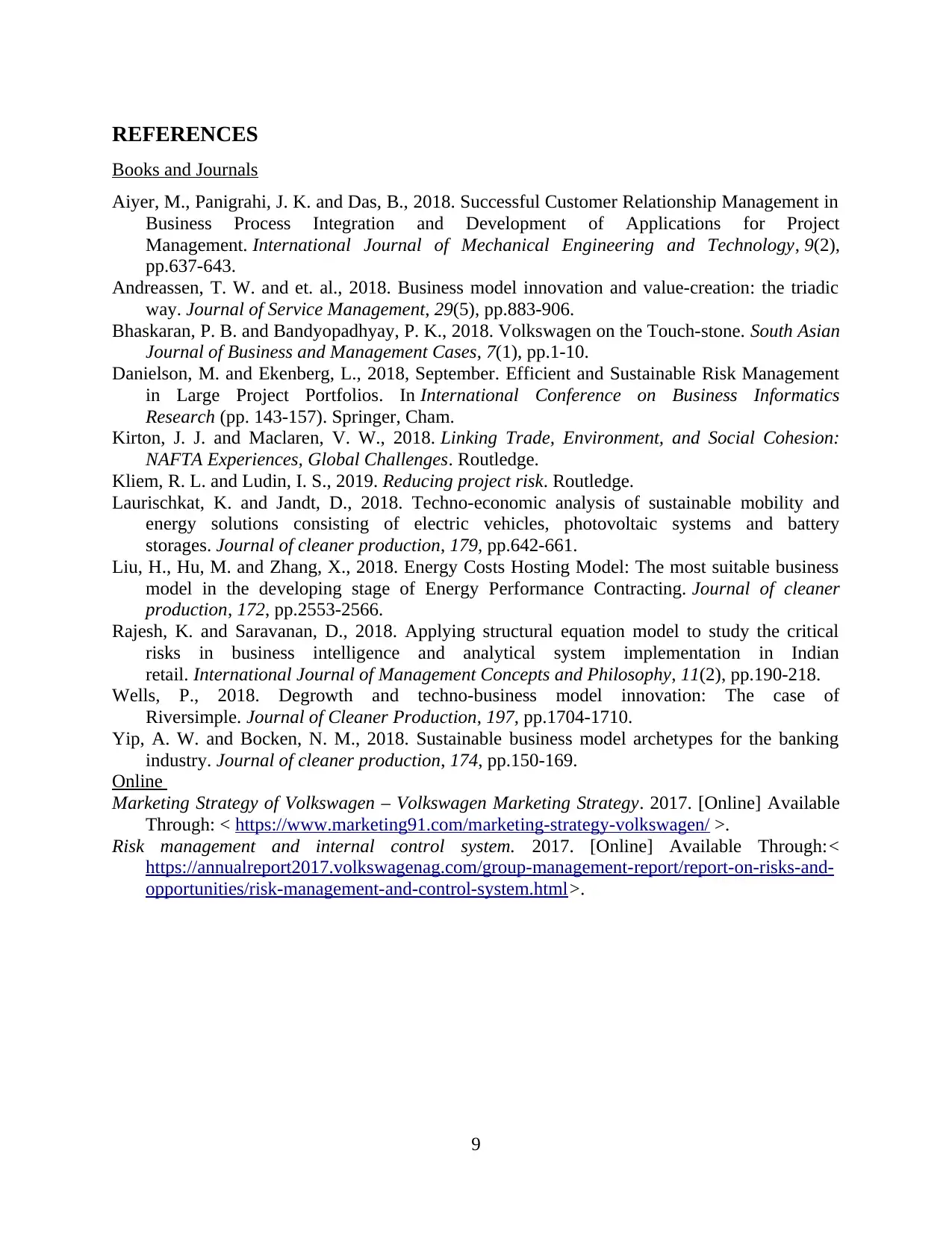
REFERENCES
Books and Journals
Aiyer, M., Panigrahi, J. K. and Das, B., 2018. Successful Customer Relationship Management in
Business Process Integration and Development of Applications for Project
Management. International Journal of Mechanical Engineering and Technology, 9(2),
pp.637-643.
Andreassen, T. W. and et. al., 2018. Business model innovation and value-creation: the triadic
way. Journal of Service Management, 29(5), pp.883-906.
Bhaskaran, P. B. and Bandyopadhyay, P. K., 2018. Volkswagen on the Touch-stone. South Asian
Journal of Business and Management Cases, 7(1), pp.1-10.
Danielson, M. and Ekenberg, L., 2018, September. Efficient and Sustainable Risk Management
in Large Project Portfolios. In International Conference on Business Informatics
Research (pp. 143-157). Springer, Cham.
Kirton, J. J. and Maclaren, V. W., 2018. Linking Trade, Environment, and Social Cohesion:
NAFTA Experiences, Global Challenges. Routledge.
Kliem, R. L. and Ludin, I. S., 2019. Reducing project risk. Routledge.
Laurischkat, K. and Jandt, D., 2018. Techno-economic analysis of sustainable mobility and
energy solutions consisting of electric vehicles, photovoltaic systems and battery
storages. Journal of cleaner production, 179, pp.642-661.
Liu, H., Hu, M. and Zhang, X., 2018. Energy Costs Hosting Model: The most suitable business
model in the developing stage of Energy Performance Contracting. Journal of cleaner
production, 172, pp.2553-2566.
Rajesh, K. and Saravanan, D., 2018. Applying structural equation model to study the critical
risks in business intelligence and analytical system implementation in Indian
retail. International Journal of Management Concepts and Philosophy, 11(2), pp.190-218.
Wells, P., 2018. Degrowth and techno-business model innovation: The case of
Riversimple. Journal of Cleaner Production, 197, pp.1704-1710.
Yip, A. W. and Bocken, N. M., 2018. Sustainable business model archetypes for the banking
industry. Journal of cleaner production, 174, pp.150-169.
Online
Marketing Strategy of Volkswagen – Volkswagen Marketing Strategy. 2017. [Online] Available
Through: < https://www.marketing91.com/marketing-strategy-volkswagen/ >.
Risk management and internal control system. 2017. [Online] Available Through:<
https://annualreport2017.volkswagenag.com/group-management-report/report-on-risks-and-
opportunities/risk-management-and-control-system.html>.
9
Books and Journals
Aiyer, M., Panigrahi, J. K. and Das, B., 2018. Successful Customer Relationship Management in
Business Process Integration and Development of Applications for Project
Management. International Journal of Mechanical Engineering and Technology, 9(2),
pp.637-643.
Andreassen, T. W. and et. al., 2018. Business model innovation and value-creation: the triadic
way. Journal of Service Management, 29(5), pp.883-906.
Bhaskaran, P. B. and Bandyopadhyay, P. K., 2018. Volkswagen on the Touch-stone. South Asian
Journal of Business and Management Cases, 7(1), pp.1-10.
Danielson, M. and Ekenberg, L., 2018, September. Efficient and Sustainable Risk Management
in Large Project Portfolios. In International Conference on Business Informatics
Research (pp. 143-157). Springer, Cham.
Kirton, J. J. and Maclaren, V. W., 2018. Linking Trade, Environment, and Social Cohesion:
NAFTA Experiences, Global Challenges. Routledge.
Kliem, R. L. and Ludin, I. S., 2019. Reducing project risk. Routledge.
Laurischkat, K. and Jandt, D., 2018. Techno-economic analysis of sustainable mobility and
energy solutions consisting of electric vehicles, photovoltaic systems and battery
storages. Journal of cleaner production, 179, pp.642-661.
Liu, H., Hu, M. and Zhang, X., 2018. Energy Costs Hosting Model: The most suitable business
model in the developing stage of Energy Performance Contracting. Journal of cleaner
production, 172, pp.2553-2566.
Rajesh, K. and Saravanan, D., 2018. Applying structural equation model to study the critical
risks in business intelligence and analytical system implementation in Indian
retail. International Journal of Management Concepts and Philosophy, 11(2), pp.190-218.
Wells, P., 2018. Degrowth and techno-business model innovation: The case of
Riversimple. Journal of Cleaner Production, 197, pp.1704-1710.
Yip, A. W. and Bocken, N. M., 2018. Sustainable business model archetypes for the banking
industry. Journal of cleaner production, 174, pp.150-169.
Online
Marketing Strategy of Volkswagen – Volkswagen Marketing Strategy. 2017. [Online] Available
Through: < https://www.marketing91.com/marketing-strategy-volkswagen/ >.
Risk management and internal control system. 2017. [Online] Available Through:<
https://annualreport2017.volkswagenag.com/group-management-report/report-on-risks-and-
opportunities/risk-management-and-control-system.html>.
9

10
1 out of 13
Related Documents
Your All-in-One AI-Powered Toolkit for Academic Success.
+13062052269
info@desklib.com
Available 24*7 on WhatsApp / Email
![[object Object]](/_next/static/media/star-bottom.7253800d.svg)
Unlock your academic potential
© 2024 | Zucol Services PVT LTD | All rights reserved.





